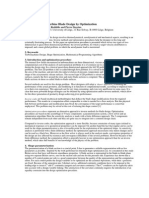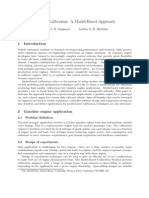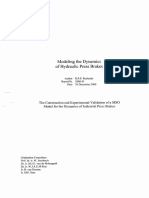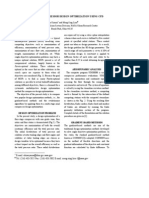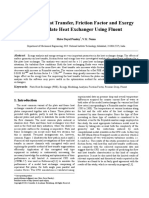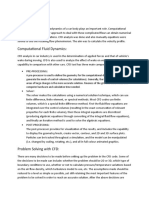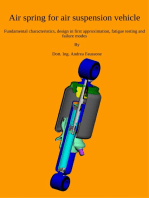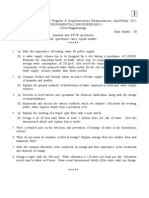CFD Optimization With Altair Hyperworks: in This Issue July 2006
CFD Optimization With Altair Hyperworks: in This Issue July 2006
Uploaded by
slv_prasaadCopyright:
Available Formats
CFD Optimization With Altair Hyperworks: in This Issue July 2006
CFD Optimization With Altair Hyperworks: in This Issue July 2006
Uploaded by
slv_prasaadOriginal Description:
Original Title
Copyright
Available Formats
Share this document
Did you find this document useful?
Is this content inappropriate?
Copyright:
Available Formats
CFD Optimization With Altair Hyperworks: in This Issue July 2006
CFD Optimization With Altair Hyperworks: in This Issue July 2006
Uploaded by
slv_prasaadCopyright:
Available Formats
IN THIS ISSUE
July 2006
CFD Optimization
Support Tips and Tricks
Altair Engineering in the News
IMPROVED PROCESS INTEGRATION
CFD Optimization with Altair HyperWorks
In the past few years, computational fluid dynamics (CFD) has been established as a widely used tool for product development. Powerful computers and sophisticated models enable the design engineer to understand the physical phenomena in the flow field and to investigate the sensitivity to various parameters. Traditionally, engineers use these results to achieve an optimum design using a trial-and-error process: Change the design, run the analysis and review the results. With these results using their experience and product knowledge engineers update the design and repeat the above process until they are satisfied with the results. Depending on the complexity of the model, this method can be time-consuming and error-prone. For engineers, this method is repetitive, with little room for exploration. Furthermore, since no mathematical optimization strategy is used, finding an optimal design is unlikely. Numerical optimization is an alternative to the traditional trial-and-error design method. Numerical design optimization is an automated iteration process that uses mathematical tools to find the optimal design for a given design criteria. The optimization problem is formulated, using design variables, objective and constraint function(s). The objective function measures the quality of a design. Constraints are design requirements, and they have to be satisfied by the optimal design. Both the objective and the constraints are functions of design variables. So, the optimization problem reads as follows: Find the design variable values that minimize (maximize) the objective function and satisfy the design constraints.
The Optimization Process
Fig. 1 Optimization process with HyperStudy. Altair's HyperStudy, a solver-neutral optimization tool, is the driver in the developed process. First, the user defines the design variables (DV), objective and design constraints. Then, HyperStudy starts the optimization loop and performs solver runs with varying DV combinations automatically. After each iteration, system responses are extracted, and the objective function and constraints values are evaluated. The DV combinations are then updated according to the algorithm chosen for optimization. The optimization procedure stops when the algorithm converges to a design that satisfies all the design constraints (a feasible design) and maximizes or minimizes the objective
function. In the above process, geometrical changes (known as shapes) are used as design variables and, therefore, the process of optimization is called shape optimization. Altairs morphing tool, HyperMorph, included in the HyperMesh environment, is used for the definition of shapes. For the morphing process, the grid of the basic geometry is parameterized and divided into domains. On certain nodes, handles are defined and assigned to a specific domain. Handles can be used to modify the grid. By moving a handle, only the nodes in the associated domain are affected, and local shape modifications can be created. Mesh distortion is minimized by applying smoothing algorithms.
Fig. 2 :The basic grid with a translation vector for a handle (left) and the modified, morphed, grid (right). The left side of Figure 2 shows the base grid, a translation vector and the handle denoted by the black dot. By moving the handle in the direction V, all the nodes in the associated domain (bounded by the dashed line) are modified. Different grid changes can be defined by formulating the translation of the handle as weight multiplied by the translation vector. The value of the weight ranges between a lower and an upper bound. In the right part of Figure 2, the handle has been translated by the vector. This technology allows the definition of various shapes on a base grid; these shapes are then used as design variables in optimization. Node-ID and cell-ID are left unchanged while the nodal coordinates are modified. The parameterized shapes are exported with HyperMesh. HyperStudy automates processes for parametric studies, design of experiments (DOE), optimization and stochastic studies. DOE studies are used to investigate the sensitivity of the system responses with respect to changes in the design variables. Several DOE methods are available in HyperStudy. Based on the DOE results, an approximate response surface can be created and used for optimization and stochastic studies. The stochastic analysis capabilities in HyperStudy allow engineers to investigate the sensitivity of the design to changes in the design environment, e.g. tolerances in material properties or manufacturing tolerances. Stochastic studies provide qualitative guidance to improve and optimize the reliability and/or robustness of designs. HyperStudy has two optimization algorithms: the method of feasible directions (MFD) and sequential response surface method (SRSM). Both methods use gradient-based algorithms. MFD is better suited for problems with design variable changes with small ranges and for linear problems. SRSM is the suggested method for general cases. In SRSM, the system responses are approximated by a quadratic polynomial that is determined in each iteration step from the results of the current and earlier iterations. A least-square method is used to define the polynomial. Example: Optimization of a Swirl Duct in a Diesel Direct-Injection Engine Driven by increasing fuel prices and more stringent emission restrictions, engineers are developing new techniques to increase the efficiency of diesel engines. One key point of these developments is the air-fuel mixture in the combustion chamber. More control of the combustion process results in less fuel consumption and yields a better emission value. In this example, a swirl duct is optimized, coupling StarCD and HyperStudy.
Fig. 3: Numerical model for the inlet maniford cylinder configuration. The air for combustion comes through the inlet manifold. Before the air enters the cylinder, it runs through the swirl duct, in which the air swirl amplitude is increased. This ensures a good air-fuel mixture in the combustion chamber necessary for an optimal
ignition process. Figure 3 shows the model for the CFD simulation of the inlet manifold and cylinder configuration. This model consists of 200,000 cells, air at 20o C, and one bar is used for the simulation. The flow is driven by a pressure difference between the inlet manifold and the cylinder. The standard k-epsilon turbulence model is used. Swirl ducts are an important part of the diesel direct-injection engines. Swirl ducts are characterized by the air mass flow rate and by the swirl factor, which is a relation between the axial torque and the volume flow rate. Generally speaking, these two factors are opposed to each other. A high swirl factor comes with a low air mass flow rate, and vice versa. Depending on the load of the engine, different demands on the air mass flow rate and the swirl factor must be met. Four different shape modifications created with HyperMorph are applied to the swirl duct to investigate the effects of the swirl ducts shape on the air mass flow rate and the swirl factor (Fig. 4). The shapes are applied with factors W1, W2, W3, W4, ranging between a lower and an upper bound. Thus, continuous transitions between the original shapes and the modified shapes are feasible. The four shapes are considered as design variables.
Fig. 4: Shape variations of the swirl duct created with HyperMorph. In this example, two different objectives are investigated. First, the air mass flow rate is maximized with a constraint on the minimum required swirl factor. This combination is preferable for the full load condition of the engine. Secondly, the swirl factor is minimized to find out the limit of the shape configurations. Here, no constraint is applied. In the first step, a DOE study is carried out to analyze the sensitivity of the system to the design variables. Several runs with different shape configurations are made and the behavior of the swirl factor and the air mass flow rate are as shown in Figure 5.
Fig. 5: Sensitivity of mass flow rate (left) and swirl factor (right) with respect to shape modifications of the swirl duct. If Shapes 1, 2 and 3 are applied, starting from their lower bound to upper bound, the diameter of the swirl ducts inlet part is extended, and more air can pass through it. As a result, the air mass flow rate increases. When Shape 4 is applied, the twisted section is affected and the mass flow rate decreases. The swirl factor S-65 is measured 65 mm below the flat cylinder head following Tippelmanns definition. Applying Shapes 1 and 3 decreases the swirl factor, while applying Shapes 2 and 4 increases it. The aforementioned opposing effects of air mass flow rate and swirl factor can be observed for Shapes 1, 3 and 4. In the second step, an optimization study is performed. The objective is to maximize the air mass flow rate while keeping the swirl factor S-65 above a specified value. HyperStudy automatically applies different shape combinations and runs the associated CFD simulations to find the optimum combination of shapes variables.
Fig. 6: Iteration histories for the objective: Maximize the mass flow rate (top left), swirl factor (top right) and design variables history (bottom). Figure 6 shows some results of the optimization study. The top left graph shows the history of the mass flow rate compared to the iteration cycles. The variations in the swirl factors can be seen in the top right graph, where two additional swirl factors are shown. The S-20 factor is determined 20 mm below the cylinder head and S-av is an average swirl factor over the whole cylinder domain. Iteration histories of the shape variables are shown in the lower graph. Shapes 2, 3 and 4 are applied with factors ranging between 0.0 and 1.0, while the factor for Shape 1 ranges between -0.1 and 1.0. In the first iteration, a baseline simulation is performed. Iterations 2 to 4 can be considered as a quick DOE study to investigate the sensitivity of the four design variables. The optimization stops after nine iterations. Compared to the initial value, mass flow rate is increased by 3%. Considering that the basic configuration was already experimentally optimized, the numerical optimization yields an additional improvement.
Fig. 7: Optimization with the objective of minimizing the swirl factor (left) with no restriction. The mass flow rate (left) increases while applying various shape configurations (right). In the third step, an optimization study to minimize the swirl factor S-65 is performed. The same shape variables are used, but no constraints are imposed (unconstrained formulation). This study provides information about the swirl factor limit in the defined design space of the swirl duct. With the optimal shape combination, the swirl factor can be reduced by 20%. In return, the mass flow rate increases by 6%. The optimization study yields a fully applied Shape 3. This result is consistent with the DOE results (Figure 5, right), where Shape 3 has a strong negative slope in the swirl factor sensitivity plot. HyperWorks Tools Add Process Value Used together, HyperMorph and HyperStudy are efficient and user-friendly tools for process integration, DOE, optimization and stochastic studies for CFD applications. With better process integration, engineers have fewer repetitive and non-value-added tasks. Using DOE, optimization and stochastic studies leads to optimized, reliable and robust designs as well as to a better understanding of the design performance.
SUPPORT TIPS & TRICKS KB#1: 708 Creating a bar element with a desired orientation vector PDF KB#2: 709 Using Mass as a response for HyperStudy PDF HYPERWORKS ADDITIONAL MACROS
UPCOMING EVENTS In the near future, Altair is participating in the following events: Altair "India/ASEAN" CAE Users Conference 2006 Aug. 3-5, 2006 Bangalore, India Click here for more info Altair Technology
Macro name: RenumberAllButSome This HyperMesh macro renumbers all entities in the model, while allowing the user to exclude some identities of any entity, such as nodes. Using this macro is very similar to that of the renumber panel in HyperMesh ("all" option). The macro will renumber or offset all entities in the model, except those selected to be excluded. Download Macro name: RenumberByPath This HyperMesh macro renumbers selected nodes in the model, while allowing the user to select nodes by path. The macro will renumber nodes in the model in ascending order. Download MARK YOUR CALENDARS FOR ALTAIR'S FIRST HTC Altair Engineering is pleased to announce the First Annual HyperWorks Technology Conference (HTC) to be held Tuesday and Wednesday, Sept. 26 and 27, 2006, in Troy, Mich. The conference merges Altairs Optimization Technology Conference a leading yearly industry forum with our annual Altair Technology Seminar. The new HTC will encompass all facets of CAE technology as they relate to advanced product design. For more information and to register, visit www.altair.com/HTC2006 today.
Seminar: The Optimization-Driven Design Process Aug. 8, 2006 So Paulo, Brazil Click here for more info The HyperWorks Engineering Framework Global Seminar Series Aug. 10, 2006 Indianapolis, Ind. Click here for more info The HyperWorks Engineering Framework Global Seminar Series Aug. 17, 2006 Grand Rapids, Mich. Click here for more info SAE 2006 General Aviation Technology Conference Aug. 29-31, 2006 Wichita, Kan. Click here for more info
NEWSLETTER FORMAT If you are unable to see the pictures in this email, please view the PDF. If you are unable to access the PDF or did not receive the attachments, please contact info-update@altair.com. REGISTER TODAY If you are new to this site or have not registered as an Insider user, we invite you to complete a brief sign-up form. As a registered user, you will have access to other support resources, including documentation, tutorials, software updates and macros. You will also have access to the iExchange message board.
TRAINING COURSES
Develop your skills
Here are upcoming HyperWorks training courses. Simply click on the course title to view details on the course content. Michigan training classes
q
Introductory FEA Modeling and Results Visualization, Aug. 7-8 www.altair.com/support/training/desc_hm1.htm Interfacing HyperWorks with ABAQUS, Aug. 10 www.altair.com/support/training/desc_hm3.htm Introduction to HyperMorph, Aug. 14 www.altair.com/support/training/desc_hm5.htm Introductory Concept Design and Fine Tuning with OptiStruct, Aug. 15-16 www.altair.com/support/training/desc_os.htm Introductory DOE, Optimization and Stochastic Studies, Aug. 17 www.altair.com/support/training/desc_hs.htm Advanced HyperMorph, Aug. 18 www.altair.com/support/training/desc_hm6.htm Introduction to Managing and Using PBS Professional, Aug. 21-23 www.altair.com/support/training/desc_pbs.htm Introductory FEA Modeling and Results Visualization, Aug. 28-30 www.altair.com/support/training/desc_hm1.htm Introductory MBD Modeling and Results Visualization, Aug. 28-29 www.altair.com/support/training/desc_mv1.htm Aspects of Model Definition Language, Aug. 30 www.altair.com/support/training/desc_mv2.htm Interfacing HyperWorks with LS-Dyna, Aug. 31 www.altair.com/support/training/desc_hm2.htm Flexible Bodies for MBD, Aug. 31 www.altair.com/support/training/desc_mv3.htm
Subscribe free to Altairs Concept to Reality. Latest magazine available now.
California training classes
q
Introductory FEA Modeling and Results Visualization, Aug. 8-10 www.altair.com/support/training/desc_hm1.htm
Wisconsin training classes
q
Introductory FEA Modeling and Results Visualization, Aug. 15-17 www.altair.com/support/training/desc_hm1.htm
>> For more details on these courses, to obtain a full schedule or to inquire about customized onsite training, call your local Altair office or email training@altair.com. ALTAIR IN THE NEWS Altair Engineering and AMD Collaborate to Deliver Low-Cost, High-Performance Computing- Link Altair Engineering and Open iT Partner to Provide Enhanced Grid Solutions to the HPC Community - Link Altair Engineering to Acquire Mecalog Group and Its RADIOSS Technology Suite - Link Altair Engineering Partners with Permedia Research Group to Integrate PBS Professional with MPath Geosciences Simulator - Link Ferretti Group Selects Altair Engineerings HyperWorks Optimization Technology to Improve Design - Link
Support inquiry? Unable to access the web links above? Please email hwsupport@altair.com or call 248-614-2425 for assistance. For more information about Altair Engineering, visit www.altair.com
Feedback on this message? Please email info-update@altair.com If you no longer wish to receive this monthly email, send an email with "remove" in the Subject to info-update@altair.com
You might also like
- Shape Optimization Methodology 2010Document15 pagesShape Optimization Methodology 2010Matias MarticorenaNo ratings yet
- Compressor and Turbine Blade Design by OptimizationDocument3 pagesCompressor and Turbine Blade Design by OptimizationalkadyasNo ratings yet
- Analysis and Enhancement of Hydraulic Ram Pump Using Computational Fluid Dynamics (CFD)Document25 pagesAnalysis and Enhancement of Hydraulic Ram Pump Using Computational Fluid Dynamics (CFD)IJIRSTNo ratings yet
- Engine CalibrationDocument8 pagesEngine CalibrationbiopoweredNo ratings yet
- UNIT III Material Advance Theory of IC EnginesDocument17 pagesUNIT III Material Advance Theory of IC EnginesRajkamal PNo ratings yet
- AHS2011 HECC Design Final PDFDocument15 pagesAHS2011 HECC Design Final PDFKarl GlorstadNo ratings yet
- Clinching Simulation IIIDocument4 pagesClinching Simulation IIIMatteoNo ratings yet
- Modeling Press Brake Machine PDFDocument88 pagesModeling Press Brake Machine PDFLê Duy MinhNo ratings yet
- A Multi-Stage Compressor Design Optimization Using CFD: Pareto-Optimal Solutions. These Solutions AreDocument3 pagesA Multi-Stage Compressor Design Optimization Using CFD: Pareto-Optimal Solutions. These Solutions AreHendrico DecoNo ratings yet
- Exp FinalDocument4 pagesExp Finalhugo mendozaNo ratings yet
- Optimization of A Plant Cooling System DesignDocument13 pagesOptimization of A Plant Cooling System DesignkglorstadNo ratings yet
- Development of High Specific Speed Francis Turbine For Low Head HPPDocument10 pagesDevelopment of High Specific Speed Francis Turbine For Low Head HPPWalter JosephNo ratings yet
- Computer and FluidsDocument19 pagesComputer and Fluidsanhntran4850No ratings yet
- Ecp 1106304Document9 pagesEcp 1106304boroumandNo ratings yet
- UntitledDocument29 pagesUntitledTerryNo ratings yet
- Overview of CFD Verification and ValidationDocument31 pagesOverview of CFD Verification and ValidationJohn ArmlessNo ratings yet
- Chaquet&CarmonaDocument19 pagesChaquet&CarmonaUNsha bee komNo ratings yet
- Compressor Performance Map Generation and Testing Per SAE J1723Document40 pagesCompressor Performance Map Generation and Testing Per SAE J1723DoctorObermanNo ratings yet
- Willans Line ArticleDocument8 pagesWillans Line Articlealiscribd46100% (1)
- Effect of Vortex Generators On Aerodynamics of A Car: CFD AnalysisDocument10 pagesEffect of Vortex Generators On Aerodynamics of A Car: CFD AnalysisVineet SinghNo ratings yet
- Rigrous Heat Exchanger SimulationDocument6 pagesRigrous Heat Exchanger SimulationJayakumar PararasuramanNo ratings yet
- WP Shape Optimization For Aero Efficiency Adjoint MethodsDocument9 pagesWP Shape Optimization For Aero Efficiency Adjoint MethodsNasir IqbalNo ratings yet
- Jsir 72 (6) 373-378Document6 pagesJsir 72 (6) 373-378mghgolNo ratings yet
- 2.1 Nature and Objectives of Actuator Design AnalysisDocument51 pages2.1 Nature and Objectives of Actuator Design AnalysisJNo ratings yet
- Optimized Location of Air-Conditioning Unit Inside Office Room To Obtain Good Thermal ComfortDocument6 pagesOptimized Location of Air-Conditioning Unit Inside Office Room To Obtain Good Thermal ComfortKVSRIT Dept. of MENo ratings yet
- Analysis of Heat Transfer, Friction Factor and Exergy Loss in Plate Heat Exchanger Using FluentDocument8 pagesAnalysis of Heat Transfer, Friction Factor and Exergy Loss in Plate Heat Exchanger Using FluentFadi YasinNo ratings yet
- 3D Modeling Axial FanDocument20 pages3D Modeling Axial FandiahNo ratings yet
- Conceptual Optimization of Axial-Flow Hydraulic Turbines With Non-Free Vortex Design PDFDocument15 pagesConceptual Optimization of Axial-Flow Hydraulic Turbines With Non-Free Vortex Design PDFArik AprilliyantoNo ratings yet
- A Critical Review On CFD Analysis of Centrifugal Pump ImpellerDocument7 pagesA Critical Review On CFD Analysis of Centrifugal Pump ImpellervishallchhayaNo ratings yet
- Axial Turbine Stages Design 1D 2D 3D Simulation Experiment OptimizationDocument10 pagesAxial Turbine Stages Design 1D 2D 3D Simulation Experiment OptimizationAditya SawantNo ratings yet
- Mathematical Modeling of CompressorsDocument16 pagesMathematical Modeling of Compressorshemanth_satish50% (2)
- Extraction and Visualization of Swirl and Tumble Motion From Engine Simulation DataDocument15 pagesExtraction and Visualization of Swirl and Tumble Motion From Engine Simulation Dataslv_prasaadNo ratings yet
- 10 1 1 98 9640 PDFDocument7 pages10 1 1 98 9640 PDFDev RaiNo ratings yet
- Automatic Shape Optimization of A Hydraulic TurbinDocument7 pagesAutomatic Shape Optimization of A Hydraulic TurbinCarolina CuevasNo ratings yet
- Investigating Diesel Engine Performance and Emissions Using CFDDocument10 pagesInvestigating Diesel Engine Performance and Emissions Using CFDmfmechanics2020No ratings yet
- CFD TutorialDocument35 pagesCFD TutorialAngel CerriteñoNo ratings yet
- C.R. Siqueira - 3d Transient Simulation of An Intake Manifold CFD - SAE 2006-01-2633Document7 pagesC.R. Siqueira - 3d Transient Simulation of An Intake Manifold CFD - SAE 2006-01-2633Thomas MouraNo ratings yet
- Design Improvement of Steering Knuckle Component Using Shape OptimizationDocument5 pagesDesign Improvement of Steering Knuckle Component Using Shape OptimizationIJEC_EditorNo ratings yet
- Some Applications 2812Document4 pagesSome Applications 2812Meterpreter TcpdumpNo ratings yet
- Axial Fan CFD Designing PDFDocument6 pagesAxial Fan CFD Designing PDFuuur35No ratings yet
- New StylesDocument4 pagesNew StylesKarimPrinceAddoNo ratings yet
- Impact of Geometric Scaling On Centrifugal Compressor PerformanceDocument12 pagesImpact of Geometric Scaling On Centrifugal Compressor PerformanceRonald George100% (1)
- Hydrofoil P72039Document20 pagesHydrofoil P72039Pukhraj DagaNo ratings yet
- Technical Paper SampleDocument8 pagesTechnical Paper SampleKarthik AbhiNo ratings yet
- Optimization in Design of Electric MachinesDocument10 pagesOptimization in Design of Electric MachinesRituvic PandeyNo ratings yet
- Assign 5Document8 pagesAssign 5c2507780No ratings yet
- Fluid CFD ReportDocument5 pagesFluid CFD Reportjawad khalidNo ratings yet
- Case Study - Gas Turbine Combustor DesignDocument9 pagesCase Study - Gas Turbine Combustor DesignSanthosh LingappaNo ratings yet
- Compressor Station Optimization Using Simulation-Based OptimizationDocument10 pagesCompressor Station Optimization Using Simulation-Based OptimizationAmbrish SinghNo ratings yet
- CFD Analysis of Screw Compressor Performance: Ahmed Kovacevic, Nikola Stosic and Ian K. SmithDocument28 pagesCFD Analysis of Screw Compressor Performance: Ahmed Kovacevic, Nikola Stosic and Ian K. Smithmahesh_1402No ratings yet
- A New Automotive Air Conditioning System Simulation Tool Developed in MATLAB/SimulinkDocument15 pagesA New Automotive Air Conditioning System Simulation Tool Developed in MATLAB/SimulinkPrashant IngaleNo ratings yet
- (16 17) OptimizationDocument29 pages(16 17) OptimizationSSNo ratings yet
- 2015-SAE-Prediction of High Altitude Performance For UAV Engine PDFDocument6 pages2015-SAE-Prediction of High Altitude Performance For UAV Engine PDF128mansouriNo ratings yet
- Variable Trim Compressor - A New Approach To Variable Compressor GeometryDocument10 pagesVariable Trim Compressor - A New Approach To Variable Compressor GeometryAlbert CalderonNo ratings yet
- A Systematic Approach Towards Automated Control Design For Heavy-Duty EGR Diesel EnginesDocument6 pagesA Systematic Approach Towards Automated Control Design For Heavy-Duty EGR Diesel Engines11751175No ratings yet
- Estiamion and ResidualDocument11 pagesEstiamion and Residualanuj1166No ratings yet
- Control SystemDocument10 pagesControl Systemrajeswari_ece07No ratings yet
- Control of DC Motor Using Different Control StrategiesFrom EverandControl of DC Motor Using Different Control StrategiesNo ratings yet
- A First Course in Dimensional Analysis: Simplifying Complex Phenomena Using Physical InsightFrom EverandA First Course in Dimensional Analysis: Simplifying Complex Phenomena Using Physical InsightNo ratings yet
- JNTUA Mechanical Engineering (R09) Syllabus BookDocument147 pagesJNTUA Mechanical Engineering (R09) Syllabus Bookslv_prasaad0% (1)
- Worm GearsDocument4 pagesWorm Gearsnitesh_n2840No ratings yet
- 9A03504 Design of Machine Elements 21Document8 pages9A03504 Design of Machine Elements 21slv_prasaadNo ratings yet
- r7320101 Geotechnical Engineering IDocument1 pager7320101 Geotechnical Engineering Iprasaad08No ratings yet
- R7320105-Estimating & CostingDocument4 pagesR7320105-Estimating & Costingslv_prasaadNo ratings yet
- R7310305-Design of Machine Members-I2Document4 pagesR7310305-Design of Machine Members-I2slv_prasaad100% (1)
- 47 - 219 - TS4 ADocument52 pages47 - 219 - TS4 Aslv_prasaadNo ratings yet
- r7320102 Environmental EngineeringDocument4 pagesr7320102 Environmental Engineeringslv_prasaadNo ratings yet
- The Z Engine, A New Type of Car Diesel Engine Having Low Emissions, High Part Load Efficiency and Power Density and Low Manufacturing CostsDocument9 pagesThe Z Engine, A New Type of Car Diesel Engine Having Low Emissions, High Part Load Efficiency and Power Density and Low Manufacturing Costsslv_prasaadNo ratings yet
- CH 1Document21 pagesCH 1slv_prasaadNo ratings yet
- Extraction and Visualization of Swirl and Tumble Motion From Engine Simulation DataDocument15 pagesExtraction and Visualization of Swirl and Tumble Motion From Engine Simulation Dataslv_prasaadNo ratings yet
- Solar Activities For StudentsDocument6 pagesSolar Activities For Studentsslv_prasaadNo ratings yet
- Ideal Rankine CycleDocument27 pagesIdeal Rankine Cycleslv_prasaadNo ratings yet
- 2 20Document29 pages2 20slv_prasaadNo ratings yet
- Optimization Using Calculus: Convexity and Concavity of Functions of One and Two VariablesDocument22 pagesOptimization Using Calculus: Convexity and Concavity of Functions of One and Two Variablesslv_prasaadNo ratings yet

